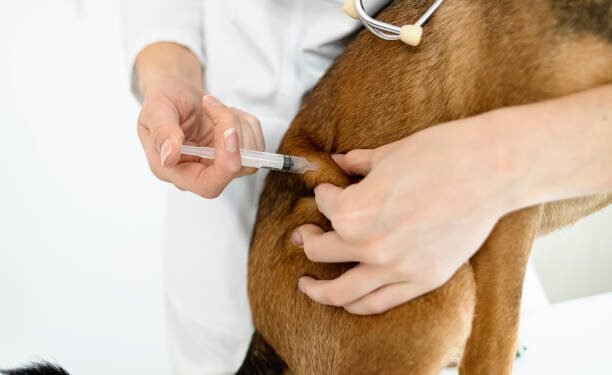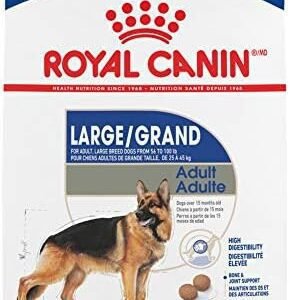Did you know that approximately 1 in 125 dogs is diagnosed with Addison’s disease, a condition that affects the adrenal glands? Fludrocortisone Acetate for dogs is a crucial medication used to manage this condition, helping to regulate electrolyte levels and maintain overall health. This synthetic corticosteroid is particularly effective in replacing the mineralocorticoids that dogs with Addison’s disease lack.
A fun fact about Fludrocortisone Acetate is that it is 125 times more potent than hydrocortisone in its mineralocorticoid activity. This makes it an incredibly powerful tool in veterinary medicine, ensuring that dogs with adrenal insufficiency can lead healthy, active lives.
When considering Fludrocortisone Acetate for your dog, it’s essential to consult with your veterinarian to determine the appropriate dosage and monitor for any potential side effects. Stay tuned to learn more about how this medication can benefit your furry friend!
Table of Contents
A Quick Overview
Fludrocortisone Acetate is a medication that has proven invaluable in the treatment of certain health issues in dogs. It’s essential to understand its details, benefits, potential side effects, and best practices for administering it. This article aims to provide pet owners and caregivers with accurate and detailed information about Fludrocortisone Acetate, empowering them to make informed decisions regarding their canine companions’ well-being.

The Information at a Glance
Let’s start by providing you with a quick reference to this medication’s critical details:
Table 1: Essential Information About Fludrocortisone Acetate
| Common Names | Fludrocortisone Acetate |
|---|---|
| Drug Type | Corticosteroid |
| Used For | Treating adrenal insufficiency, salt-wasting syndrome, and related conditions |
| Administered | Tablets, Oral liquid, Injectable |
| FDA Approved | Yes |
II. Understanding Fludrocortisone Acetate
In the world of canine healthcare, understanding the medications that can benefit our furry companions is essential. Fludrocortisone Acetate, often simply referred to as Fludrocortisone, is a medication with a significant impact on certain health conditions in dogs. In this section, we’ll explore what Fludrocortisone Acetate is, how it operates within a dog’s body, and the range of common conditions and ailments it can effectively treat and manage.
What is Fludrocortisone Acetate?
Fludrocortisone Acetate is a corticosteroid, a type of medication that closely resembles the naturally occurring hormones produced by a dog’s adrenal glands. It is a synthetic variant of aldosterone, a hormone that plays a crucial role in maintaining the body’s salt and water balance. In dogs, Fludrocortisone Acetate is primarily used to manage specific health issues related to the adrenal glands.
How Does Fludrocortisone Acetate Work in Dogs’ Bodies?
Understanding how Fludrocortisone Acetate operates within a dog’s body requires insight into its mechanism of action. When administered, Fludrocortisone Acetate is absorbed into the bloodstream and travels to the adrenal glands, where it takes on a role similar to that of aldosterone. It promotes the retention of sodium and the excretion of potassium by the kidneys, ultimately helping to maintain the proper balance of these electrolytes in the body.
By regulating these electrolyte levels, Fludrocortisone Acetate effectively manages health conditions such as salt-wasting syndrome. This condition, often seen in certain breeds, can result in an imbalance of electrolytes, leading to dehydration and related health issues. Fludrocortisone Acetate steps in to restore this balance, improving the dog’s overall well-being.
Common Conditions and Ailments Treated with Fludrocortisone Acetate
Fludrocortisone Acetate is primarily used in the treatment of adrenal insufficiency, also known as Addison’s disease, in dogs. Addison’s disease is a condition characterized by insufficient adrenal hormone production. The medication works by supplementing the lacking hormones and restoring the dog’s hormonal balance.
Additionally, Fludrocortisone Acetate can effectively manage salt-wasting syndrome, a condition more common in specific breeds like Nova Scotia Duck Tolling Retrievers. This syndrome results in the excessive loss of sodium in the urine, leading to electrolyte imbalances and the related health complications. Fludrocortisone Acetate plays a pivotal role in preventing these imbalances and improving the dog’s health and quality of life.
It’s essential to note that the use of Fludrocortisone Acetate should always be under the guidance of a veterinarian. They will diagnose the specific condition and recommend the appropriate dosage and treatment plan, ensuring the best results while minimizing potential side effects.
III. Benefits of Fludrocortisone Acetate for Dogs
Fludrocortisone Acetate, a synthetic corticosteroid with a specific focus on managing adrenal-related conditions, offers a range of benefits for dogs. In this section, we will explore the effectiveness of Fludrocortisone Acetate in treating canine health issues and how it contributes to enhancing dogs’ quality of life.
Effectiveness in Treating Specific Canine Health Issues
- Addison’s Disease Management: One of the primary applications of Fludrocortisone Acetate is the treatment of Addison’s disease, a condition where the adrenal glands fail to produce sufficient hormones. Fludrocortisone supplements the hormonal deficit effectively, helping dogs with Addison’s disease regain their vitality. This treatment is crucial for preventing life-threatening adrenal crises associated with the disease.
- Salt-Wasting Syndrome: Fludrocortisone Acetate also plays a pivotal role in managing salt-wasting syndrome, particularly in certain breeds like Nova Scotia Duck Tolling Retrievers. By regulating sodium and potassium balance, it prevents electrolyte imbalances and associated health complications, ensuring affected dogs lead healthier lives.
- Quality of Life Improvement: Beyond its primary clinical uses, Fludrocortisone Acetate enhances a dog’s overall quality of life by addressing the symptoms associated with adrenal insufficiency. This includes reducing lethargy, improving appetite, and minimizing gastrointestinal disturbances, leading to happier and more active canine companions.
How Fludrocortisone Acetate Can Improve Dogs’ Quality of Life
- Symptom Alleviation: For dogs suffering from Addison’s disease, Fludrocortisone Acetate offers relief from symptoms such as weakness, vomiting, diarrhea, and muscle tremors. By addressing these symptoms, it significantly enhances the dog’s comfort and well-being.
- Energy Restoration: Addison’s disease can leave dogs feeling weak and fatigued. Fludrocortisone Acetate helps restore their energy levels, allowing them to lead more active and enjoyable lives. Dogs on the treatment often show increased playfulness and engagement in activities.
- Appetite Improvement: Many dogs with adrenal insufficiency experience a loss of appetite. Fludrocortisone Acetate can reverse this trend, encouraging dogs to eat more regularly and maintain a healthy weight.
- Reduced Stress and Anxiety: Corticosteroids like Fludrocortisone Acetate can help reduce stress and anxiety in dogs. For dogs dealing with chronic health conditions, this can lead to an improved sense of well-being.
It’s crucial to highlight that Fludrocortisone Acetate is a prescription medication, and its use should always be overseen by a veterinarian. The dosage and treatment plan are tailored to the specific needs of each dog, ensuring the optimal balance between symptom relief and minimal side effects.
IV. Administering Fludrocortisone Acetate to Dogs
Administering Fludrocortisone Acetate to dogs is a crucial aspect of managing adrenal-related conditions like Addison’s disease and salt-wasting syndrome. In this section, we will explore the essential guidelines for administering this medication, ensuring that dog owners can provide the right dosage and ensure their pet’s well-being.

Dosage Guidelines: Determining the Right Dosage
The dosage of Fludrocortisone Acetate is determined by several factors, including the dog’s size, age, and the specific condition being treated. Veterinarians play a crucial role in assessing these variables to prescribe the most appropriate dosage for each dog. Factors that influence the dosage include:
- Body Weight: Heavier dogs typically require a higher dosage than smaller dogs. Dosages are often calculated in milligrams (mg) per kilogram (kg) of body weight.
- Severity of the Condition: The extent of adrenal insufficiency or salt-wasting syndrome also affects the required dosage. Dogs with severe conditions may need higher doses initially.
- Response to Treatment: Over time, the veterinarian may adjust the dosage based on the dog’s response to treatment. This can involve increasing or decreasing the dose as needed to achieve the desired therapeutic effect.
- Concurrent Medications: If the dog is taking other medications that interact with Fludrocortisone Acetate, the dosage may need to be adjusted to avoid adverse reactions.
Fludrocortisone Acetate Dosage Chart for Dogs by Weight
Fludrocortisone Acetate is used to treat adrenal insufficiency (Addison’s disease) in dogs. The dosage is typically based on the dog’s weight and adjusted according to their response to the medication. Here is a general dosage guide:
Standard Dosage
- Initial Dose: 0.01 mg per kilogram of body weight, administered every 12 hours.
- Maintenance Dose: Adjusted in 0.05-0.1 mg increments every 2 weeks based on serum electrolyte levels.
Example Dosage Chart
| Dog’s Weight | Initial Dose (every 12 hours) | Maintenance Dose (every 12 hours) |
|---|---|---|
| 10 lbs (4.5 kg) | 0.045 mg | 0.045-0.09 mg |
| 20 lbs (9 kg) | 0.09 mg | 0.09-0.18 mg |
| 30 lbs (13.5 kg) | 0.135 mg | 0.135-0.27 mg |
| 40 lbs (18 kg) | 0.18 mg | 0.18-0.36 mg |
| 50 lbs (22.5 kg) | 0.225 mg | 0.225-0.45 mg |
Important Considerations
- Age and Health: Older dogs or those with kidney or liver issues may require lower doses.
- Monitoring: Regular ACTH stimulation tests and serum electrolyte monitoring are essential to adjust the dosage and ensure effectiveness.
- Administration: Fludrocortisone should be given with food to reduce the risk of gastrointestinal upset.
It’s crucial to follow the veterinarian’s dosage instructions carefully. Administering the correct dose is essential for the effective management of the dog’s condition.
Frequency of Administration: Daily, Weekly, or as Needed
The frequency of Fludrocortisone Acetate administration varies depending on the specific condition and the dog’s response to treatment. Typically, this medication is given once a day, with the dog receiving its dose at the same time each day. Consistency is key to maintaining the medication’s effectiveness.
In some cases, where the condition is well-controlled, the veterinarian may recommend reducing the frequency of administration to once every other day or even less. However, these changes should always be made under the guidance of a veterinarian.
For dogs with severe adrenal insufficiency, a daily dose of Fludrocortisone Acetate is often required to ensure they receive a steady supply of necessary hormones. Salt-wasting syndrome cases may also necessitate daily dosing.
Directions for Use: Tips for Administering Fludrocortisone Acetate to Dogs
Administering Fludrocortisone Acetate may be challenging, especially if your dog is particularly finicky when it comes to taking medication. Here are some tips to make the process smoother:
- Hiding in Treats: One common technique is to hide the Fludrocortisone Acetate tablet within a treat or a small amount of food. This can be effective for dogs who are hesitant to take pills.
- Crushing or Splitting Tablets: In some cases, your veterinarian may allow you to crush or split the tablets to make them easier to administer. Be sure to consult your vet before attempting this.
- Liquid Formulation: If your dog is especially challenging to medicate, you may discuss with your vet the possibility of using a liquid form of Fludrocortisone Acetate, which can be mixed with food or given directly by mouth using a syringe.
- Consistency: Always give the medication at the same time each day to maintain a regular schedule. This helps stabilize the dog’s hormone levels.
- Watch for Rejection: Keep a close eye on your dog after administering the medication to ensure they haven’t spat it out. If this happens frequently, consult your vet for alternative methods.
Importance of Adhering to Prescribed Dosages. Missed Dose Guideline
Adhering to the prescribed dosage is critical for the effective management of adrenal conditions. Missing a dose can result in a sudden drop in hormone levels, leading to an adrenal crisis. Here’s what to do if you miss a dose:
- If You Realize Shortly After: If you realize you’ve missed a dose shortly after the scheduled time, give the missed dose as soon as you can.
- If You Realize Close to the Next Dose: If you’re nearing the time for the next scheduled dose, skip the missed dose and proceed with the next one.
- Never Double the Dose: Do not double the dose to make up for a missed one, as this can lead to an overdose.
- Contact Your Vet: Always inform your veterinarian if a dose is missed. They can provide guidance on how to proceed.
V. Potential Side Effects and Precautions
Fludrocortisone Acetate is a medication that can significantly improve the quality of life for dogs with adrenal-related conditions. However, like any medication, it may come with potential side effects, precautions, and interactions that dog owners should be aware of. In this section, we will explore these aspects to ensure the safe and effective use of Fludrocortisone Acetate in dogs.
Common Side Effects of Fludrocortisone Acetate in Dogs
While Fludrocortisone Acetate is generally well-tolerated, some dogs may experience side effects, especially when the medication is first introduced. These common side effects may include:
- Increased Thirst and Urination: Some dogs may experience increased thirst and urination as a result of the medication’s impact on electrolyte balance.
- Increased Appetite: Dogs may exhibit an increase in appetite, potentially leading to weight gain.
- Panting: Panting, often associated with restlessness or agitation, can occur as a side effect of Fludrocortisone Acetate.
- Vomiting or Diarrhea: Gastrointestinal upset, including vomiting and diarrhea, may be observed in some cases.
- Potassium Loss: The medication can lead to the loss of potassium from the body, which may manifest as muscle weakness or tremors.
- Hypertension: High blood pressure (hypertension) can occasionally occur as a side effect, necessitating monitoring during treatment.
It’s essential for dog owners to be aware of these potential side effects and report any unusual changes in their pet’s behavior or health to their veterinarian. In many cases, these side effects can be managed by adjusting the dosage or with additional medications.
Identifying Severe or Adverse Reactions
While most dogs tolerate Fludrocortisone Acetate well, there is a potential for severe or adverse reactions, although these are relatively rare. Dog owners should be vigilant for any of the following signs, which may indicate a severe reaction:
- Allergic Reactions: Signs of an allergic reaction can include hives, itching, facial swelling, difficulty breathing, or a sudden collapse. This is a medical emergency that requires immediate veterinary attention.
- Adrenal Crisis: Missing doses or abrupt withdrawal from Fludrocortisone Acetate can lead to an adrenal crisis. Symptoms may include vomiting, diarrhea, severe lethargy, weakness, or collapse. This is a life-threatening situation requiring urgent veterinary care.
- Excessive Thirst and Urination: While some increase in thirst and urination is normal, extreme and unrelenting polydipsia (excessive thirst) and polyuria (excessive urination) may be a sign of an issue with the treatment.
- Muscle Weakness or Tremors: Severe muscle weakness, tremors, or shaking can indicate a significant potassium loss and requires prompt medical attention.
Precautions for Pregnant or Lactating Dogs
Fludrocortisone Acetate should be used cautiously in pregnant or lactating dogs. The potential risks and benefits must be evaluated by a veterinarian. High doses or prolonged use of corticosteroids during pregnancy may lead to fetal abnormalities, so the lowest effective dose should be used when necessary.
In lactating dogs, it’s important to note that Fludrocortisone Acetate can pass into the milk, potentially affecting nursing puppies. Consult your veterinarian for guidance if you are caring for pregnant or lactating dogs.
Interactions with Other Medications or Supplements
Fludrocortisone Acetate can interact with other medications and supplements, potentially leading to adverse effects or reduced efficacy. It’s crucial for veterinarians to be aware of all the medications and supplements your dog is taking to manage potential interactions. Here are a few examples of interactions to consider:
- Non-Steroidal Anti-Inflammatory Drugs (NSAIDs): Concurrent use of NSAIDs with Fludrocortisone Acetate may increase the risk of gastrointestinal ulcers and other complications.
- Antacids: Antacids containing aluminum may reduce the absorption of Fludrocortisone Acetate. Ensure that your veterinarian is aware of any antacid use.
- Potassium supplements: Since Fludrocortisone Acetate can lead to potassium loss, concurrent use of potassium supplements may be necessary to maintain healthy potassium levels.
- Certain Vaccines: The use of live vaccines should be avoided during treatment with Fludrocortisone Acetate due to the potential for decreased vaccine efficacy.
Dog owners should inform their veterinarian about any other medications or supplements their pet is taking to ensure a safe and effective treatment plan. Your veterinarian will make necessary adjustments to prevent interactions and ensure the best possible care for your dog.
VI. Consultation with a Veterinarian
Emphasizing the Importance of Professional Guidance
Veterinarians undergo extensive training to understand the complexities of medications like Fludrocortisone Acetate and how they interact with various canine health conditions. When your dog requires medication like Fludrocortisone Acetate, it’s essential to consult a veterinarian for several reasons:
- Accurate Diagnosis: Veterinarians can accurately diagnose the underlying condition that necessitates Fludrocortisone Acetate. This is crucial as misdiagnosis can lead to inappropriate treatment.
- Proper Dosage: Determining the correct dosage for your dog’s size and condition is vital for the treatment’s success. Veterinarians take into account factors such as the dog’s weight, age, and the severity of the condition.
- Monitoring: Your vet will provide guidance on how to monitor your dog’s response to the medication and any potential side effects. They may recommend regular check-ups to ensure the treatment’s effectiveness and your dog’s well-being.
- Adverse Effects: In case of adverse reactions, your veterinarian can provide prompt care, including adjusting the dosage or recommending alternative treatments.
Overdose Information and Possible Toxicity/Effect
Overdosing on Fludrocortisone Acetate is a serious concern, as it can lead to adverse effects and complications. It’s crucial to administer the medication precisely as prescribed by your veterinarian. However, if an overdose occurs or if you suspect your dog may have ingested an excessive amount, it is essential to seek immediate veterinary care.
An overdose can lead to various symptoms, including:
- Excessive thirst and urination
- Potassium loss
- Muscle weakness or tremors
- Panting
- Gastrointestinal distress (vomiting, diarrhea)
- Lethargy
- Hypertension (high blood pressure)
Remember, in case of an overdose, time is of the essence. Delaying treatment may result in more severe complications.
Signs or Symptoms: When to Call the Vet
Even if your dog is on the correct dosage, monitoring their response to Fludrocortisone Acetate is essential. Keep an eye out for any signs or symptoms that could indicate an issue. If you notice any of the following, it’s time to pick up the phone and call your veterinarian:
- Excessive Thirst and Urination: While some increase in thirst and urination is expected, excessive and unrelenting polydipsia (excessive thirst) and polyuria (excessive urination) are causes for concern.
- Muscle Weakness or Tremors: Severe muscle weakness, tremors, or shaking can be a sign of significant potassium loss.
- Vomiting or Diarrhea: Gastrointestinal upset, including vomiting and diarrhea, may indicate a problem with the treatment.
- Panting and Restlessness: Unexplained panting, restlessness, or agitation can be associated with a variety of issues, including medication side effects.
How to Discuss Fludrocortisone Acetate with Your Veterinarian
Open communication with your veterinarian is essential for ensuring the health and well-being of your dog. When discussing Fludrocortisone Acetate, consider the following tips:
- Provide Detailed Information: Share your dog’s medical history, including any preexisting conditions, previous medications, and known allergies. The more information your veterinarian has, the better they can tailor the treatment plan.
- Ask Questions: Don’t hesitate to ask questions and seek clarification. Your veterinarian is there to help and should be willing to address your concerns.
- Express Concerns: If you have concerns about potential side effects, interactions with other medications, or any other aspect of the treatment, don’t be afraid to express them.
- Follow the Prescribed Plan: Adhere strictly to your veterinarian’s prescribed treatment plan, including the dosage and administration schedule.
Seeking a Second Opinion If Needed
In some cases, seeking a second opinion from another veterinarian can be a prudent course of action. This is especially relevant if you have reservations about the diagnosis or treatment plan, or if your dog is not responding well to the medication.
To seek a second opinion:
- Research Other Veterinarians: Look for a well-qualified and experienced veterinarian in your area. You can ask for recommendations from friends, family, or online pet communities.
- Provide Full Medical Records: When consulting the second veterinarian, ensure they have access to your dog’s complete medical history, including any ongoing treatment with Fludrocortisone Acetate.
- Ask for Their Assessment: Request a thorough assessment of your dog’s condition and their professional opinion on the current treatment.
- Consider the Recommendations: If the second opinion differs from the first, carefully consider which course of action is in your dog’s best interest. Remember that veterinarians base their diagnoses and treatment plans on their knowledge and experience.
VII. Comparison with Similar Drugs in this Category
Comparing the Efficacy of Drugs
- Fludrocortisone Acetate: This medication is a synthetic mineralocorticoid that can help regulate electrolyte balance in dogs, primarily in cases of Addison’s disease or other conditions associated with salt wasting. It’s effective in many cases but may not be the first choice for conditions where glucocorticoids are more appropriate.
- Prednisone: Prednisone is a commonly used corticosteroid with a broad range of applications. It’s highly effective in treating inflammation, allergic reactions, and autoimmune diseases. However, it’s not a mineralocorticoid and is not used for conditions requiring sodium retention.
- Fludrocortisone/Prednisone Combination: In cases where a dog requires both glucocorticoid and mineralocorticoid activity, a combination of Fludrocortisone and Prednisone may be prescribed. This approach provides the benefits of both medications.
- Dexamethasone: Dexamethasone is a powerful corticosteroid used when rapid and intense anti-inflammatory effects are needed. It’s not used as a mineralocorticoid.
- Desoxycorticosterone Pivalate (DOCP): DOCP is another mineralocorticoid used to manage conditions like primary hypoadrenocorticism (Addison’s disease). It’s an alternative to Fludrocortisone and may be preferred in some cases.
Choosing the Appropriate Medication
The choice between these medications depends on the specific condition your dog is facing and the required therapeutic effects:
- Addison’s Disease: In cases of primary hypoadrenocorticism (Addison’s disease), Fludrocortisone Acetate or Desoxycorticosterone Pivalate (DOCP) are often the preferred options to address the mineralocorticoid deficiency.
- Allergies and Inflammatory Conditions: For allergies, inflammatory conditions, and autoimmune disorders, Prednisone or other glucocorticoids are usually the primary choice due to their potent anti-inflammatory and immunosuppressive effects.
- Combination Therapy: In some instances, dogs may require a combination of medications. For example, a dog with Addison’s disease might be prescribed Fludrocortisone for mineralocorticoid replacement and Prednisone for glucocorticoid effects.
- Emergency Situations: In emergency situations with severe inflammation, Dexamethasone might be used due to its rapid and intense anti-inflammatory effects.
Comparing Costs
The cost of these medications can vary based on several factors, including the drug itself, dosage, frequency of administration, and where you purchase them. Here’s a general comparison:
- Fludrocortisone Acetate: While not considered expensive, the cost of Fludrocortisone Acetate may add up over time, especially if your dog requires long-term treatment.
- Prednisone: Prednisone is relatively affordable, making it a cost-effective option for conditions requiring glucocorticoid treatment.
- Combination Therapy: Using both Fludrocortisone Acetate and Prednisone can increase overall treatment costs but is necessary for some dogs.
- Dexamethasone: Dexamethasone may be more expensive due to its potency and fast action, but it’s typically used in short-term, emergency scenarios.
- Desoxycorticosterone Pivalate (DOCP): DOCP’s cost is comparable to Fludrocortisone and might be preferred in some cases.
When considering costs, it’s essential to think long-term and evaluate not just the price of the medication itself but also potential veterinary visits, laboratory tests, and any additional medications or supplements that may be required as part of the treatment plan.
In conclusion, the choice between Fludrocortisone Acetate and other medications in the same category depends on your dog’s specific health condition and the therapeutic effects needed. Cost considerations should also be part of the decision-making process. Consulting your veterinarian is essential to determine the most suitable treatment for your canine companion. In the final section, we’ll address common questions that dog owners often have about Fludrocortisone Acetate to provide clear and concise answers.
FAQs
Q1. What is Fludrocortisone Acetate, and how does it work for dogs?
A: Fludrocortisone Acetate is a synthetic mineralocorticoid. It works by promoting the retention of sodium (salt) and the excretion of potassium in the kidneys. This is crucial for maintaining proper electrolyte balance in your dog’s body, especially if they suffer from conditions like Addison’s disease, which results in a deficiency of natural mineralocorticoids.
Q2. What is Addison’s disease, and how is it related to Fludrocortisone Acetate?
A: Addison’s disease, also known as hypoadrenocorticism, is a condition in which the adrenal glands don’t produce enough corticosteroid hormones. Fludrocortisone Acetate is used to treat Addison’s disease in dogs. It replaces the missing mineralocorticoids and helps manage the condition effectively.
Q3. Are there any side effects of Fludrocortisone Acetate in dogs?
A: Fludrocortisone Acetate can cause side effects, including increased thirst and urination, increased appetite, panting, and, in some cases, behavioral changes. These side effects are typically dose-dependent and may resolve with a dose adjustment. If you notice any concerning side effects, consult your veterinarian.
Q4. How should I administer Fludrocortisone Acetate to my dog?
A: Fludrocortisone Acetate is often administered orally in the form of a tablet. It’s crucial to follow your veterinarian’s instructions regarding dosage and administration. You can hide the tablet in your dog’s favorite treat or food to make administration easier.
Q5. What should I do if I miss a dose of Fludrocortisone Acetate?
A: If you accidentally miss a dose, give it as soon as you remember, unless it’s close to the time for the next dose. In that case, skip the missed dose and continue with the regular schedule. Do not double the dose to make up for a missed one.
Q6. Can I discontinue Fludrocortisone Acetate if my dog’s condition improves?
A: It’s essential not to discontinue Fludrocortisone Acetate without consulting your veterinarian. The medication should be tapered gradually under their guidance to avoid a relapse of the condition. Stopping it suddenly can be harmful to your dog.
Q7. Is Fludrocortisone Acetate safe for long-term use?
A: Fludrocortisone Acetate can be used for long-term management of conditions like Addison’s disease. Your veterinarian will regularly monitor your dog’s progress and adjust the dosage as needed to ensure their well-being.
Q8. Can Fludrocortisone Acetate be given with other medications or supplements?
A: It’s essential to inform your veterinarian about all the medications, supplements, or herbal products your dog is taking. Some drugs may interact with Fludrocortisone Acetate, potentially affecting its effectiveness or causing side effects. Your veterinarian will ensure that there are no harmful interactions.
Q9. Is Fludrocortisone Acetate safe for pregnant or lactating dogs?
A: Fludrocortisone Acetate should be used with caution in pregnant or lactating dogs. It’s crucial to discuss the risks and benefits with your veterinarian. They will help you make an informed decision regarding the use of this medication during these stages.
Q10. Can I obtain Fludrocortisone Acetate without a prescription?
A: No, Fludrocortisone Acetate is a prescription medication. It’s essential to consult a veterinarian who can diagnose your dog’s condition and prescribe the appropriate treatment, including Fludrocortisone Acetate if necessary.
























